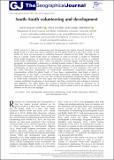Files in this item
South–South volunteering and development
Item metadata
| dc.contributor.author | Baillie Smith, Matt | |
| dc.contributor.author | Laurie, Nina | |
| dc.contributor.author | Griffiths, Mark | |
| dc.date.accessioned | 2017-11-14T11:30:10Z | |
| dc.date.available | 2017-11-14T11:30:10Z | |
| dc.date.issued | 2018-06 | |
| dc.identifier | 251533592 | |
| dc.identifier | d0fa0080-a029-43e5-afad-f2a27e6dc160 | |
| dc.identifier | 85041386671 | |
| dc.identifier | 000434177100006 | |
| dc.identifier.citation | Baillie Smith , M , Laurie , N & Griffiths , M 2018 , ' South–South volunteering and development ' , Geographical Journal , vol. 184 , no. 2 , pp. 158-168 . https://doi.org/10.1111/geoj.12243 | en |
| dc.identifier.issn | 1475-4959 | |
| dc.identifier.other | Bibtex: urn:6e2168f3ba084d15915730b5f52141c9 | |
| dc.identifier.other | ORCID: /0000-0003-0081-1404/work/64361346 | |
| dc.identifier.uri | https://hdl.handle.net/10023/12082 | |
| dc.description.abstract | While research to date on volunteering and development has largely focused attention on the global South as a place that ‘hosts’ volunteers and the global North as a place that ‘sends’, in this article we focus on movements of volunteers between countries in the South. Our objective is thus to consider ‘South–South’ flows of volunteers in order to provide a counter to dominant North–South imaginaries of international volunteering. However, we do not declare or celebrate South–South volunteering as ‘new’, rather our approach critically engages with the framing of this geography of international volunteering as offering benefits similar to those of wider South–South development cooperation. Drawing on interviews with volunteers and stakeholders in South–South volunteering, we draw out and explore three prominent themes: (1) how volunteers echo some of the wider discursive formulations of South–South development cooperation premised on commonalities within the global South; (2) how these commonalities meet limits at which a heterogeneity of the South is articulated through hierarchical orderings of relations between Southern constituents; and (3) the ways that racialised development imaginaries bring challenges to South–South volunteers. We thus argue that South–South volunteering works, re-works and contests established imaginaries of development, and their construction and ordering of sameness and difference. We argue further that caution is needed around claims of ‘newness’ of, or unqualified advocacy for, South–South volunteering, which instead needs to be subject to critical attention in the areas we highlight. | |
| dc.format.extent | 161222 | |
| dc.language.iso | eng | |
| dc.relation.ispartof | Geographical Journal | en |
| dc.subject | Asia | en |
| dc.subject | Development | en |
| dc.subject | International volunteering | en |
| dc.subject | South–South cooperation | en |
| dc.subject | Difference, new de | en |
| dc.subject | New development actors | en |
| dc.subject | G Geography (General) | en |
| dc.subject | T-NDAS | en |
| dc.subject.lcc | G1 | en |
| dc.title | South–South volunteering and development | en |
| dc.type | Journal article | en |
| dc.contributor.institution | University of St Andrews. School of Geography & Sustainable Development | en |
| dc.identifier.doi | 10.1111/geoj.12243 | |
| dc.description.status | Peer reviewed | en |
This item appears in the following Collection(s)
Items in the St Andrews Research Repository are protected by copyright, with all rights reserved, unless otherwise indicated.

